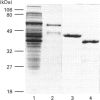Abstract
The expression of human cyclophilin 40 (CyP-40) as a glutathione S-transferase fusion protein has provided a means to identify cellular components that are in association with this ubiquitous protein. When the fusion protein was coupled to a GSH affinity matrix, heat-shock protein 90 (hsp90) was found to be the predominant associated protein in all tissue extracts examined. The relatively high concentration of each of these proteins in various tissues indicates that the dimeric complex exists in concentrations that exceed those of the inactive steroid receptors of which each protein is a component. Association does not occur with heat-shock protein 70 and is not affected by cyclosporin A (CsA). Independent expression of two domains of CyP-40 permitted dissociation of N-terminal isomerase and CsA binding activity from the hsp90 binding site, which is located at the FKBP-59-like C-terminal region. The biological association of CyP-40 with hsp90 in many tissues may reflect a conjoint role in protein folding and trafficking.
Full text
PDF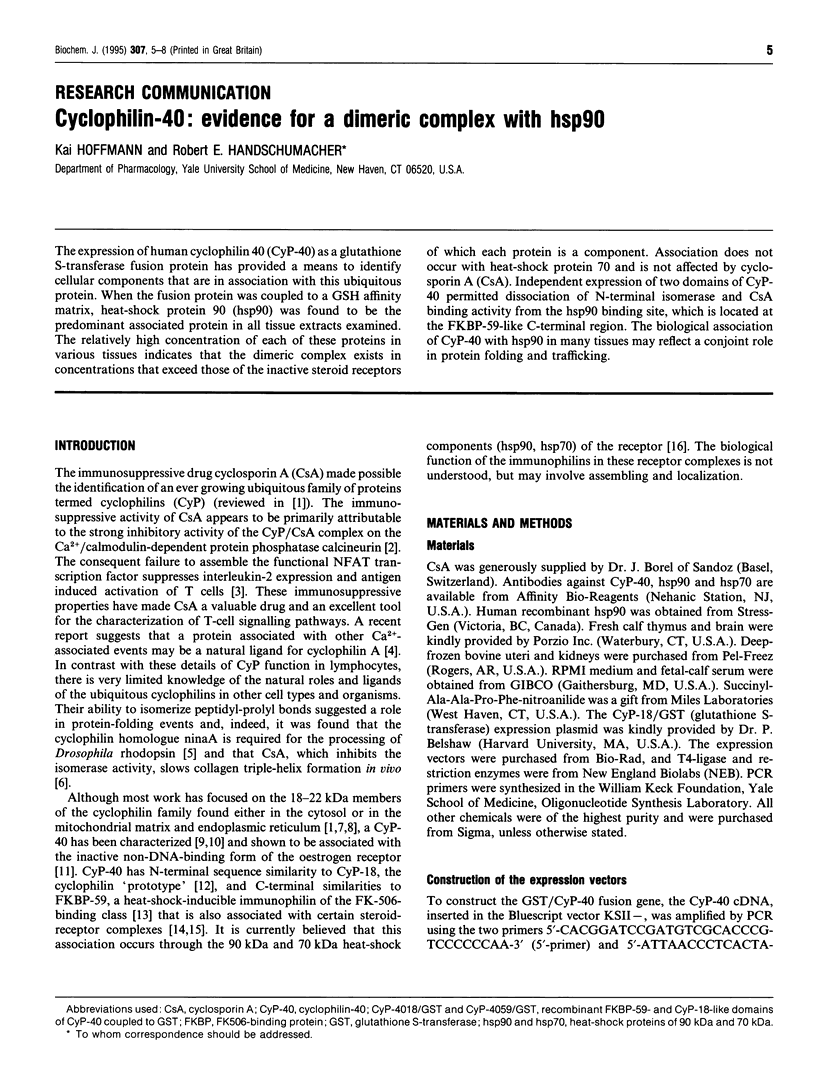
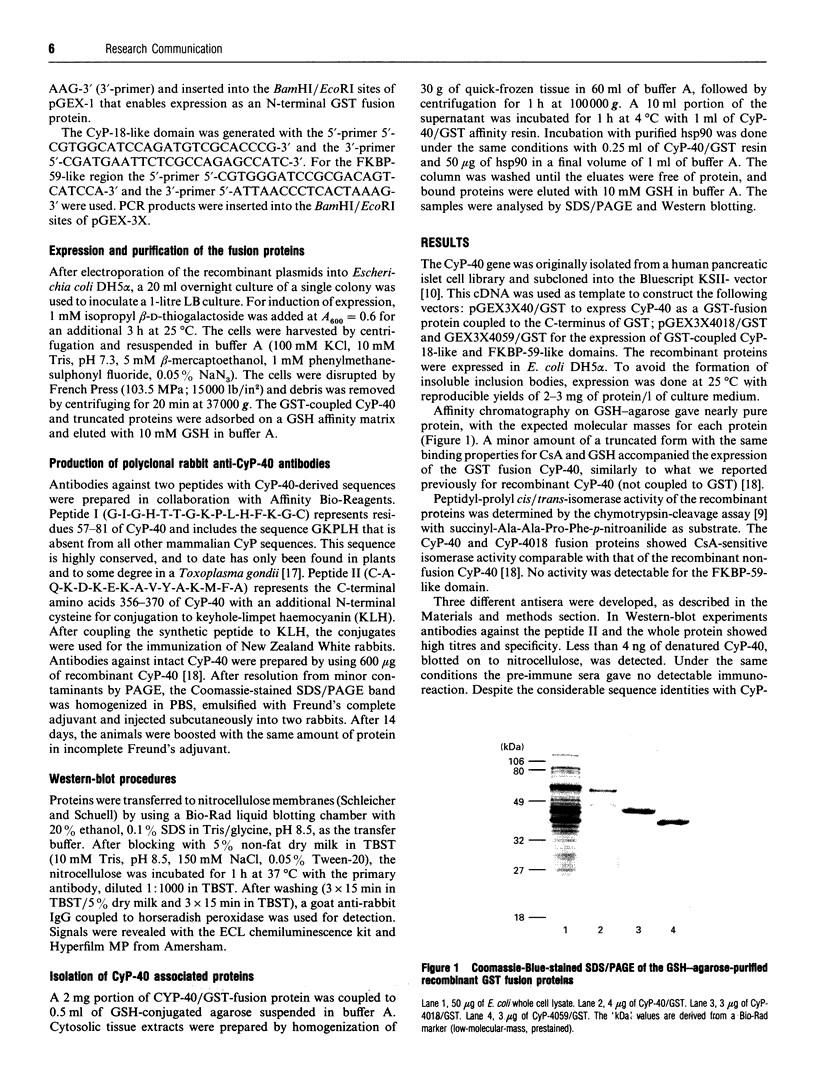
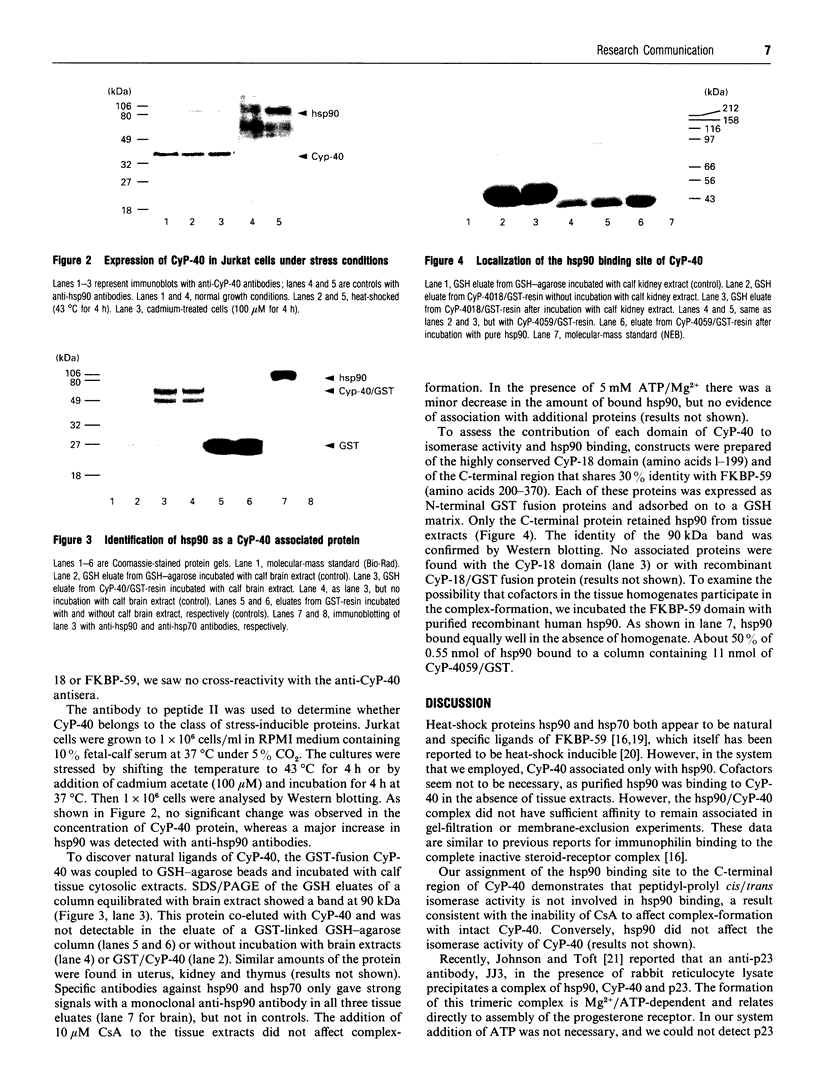
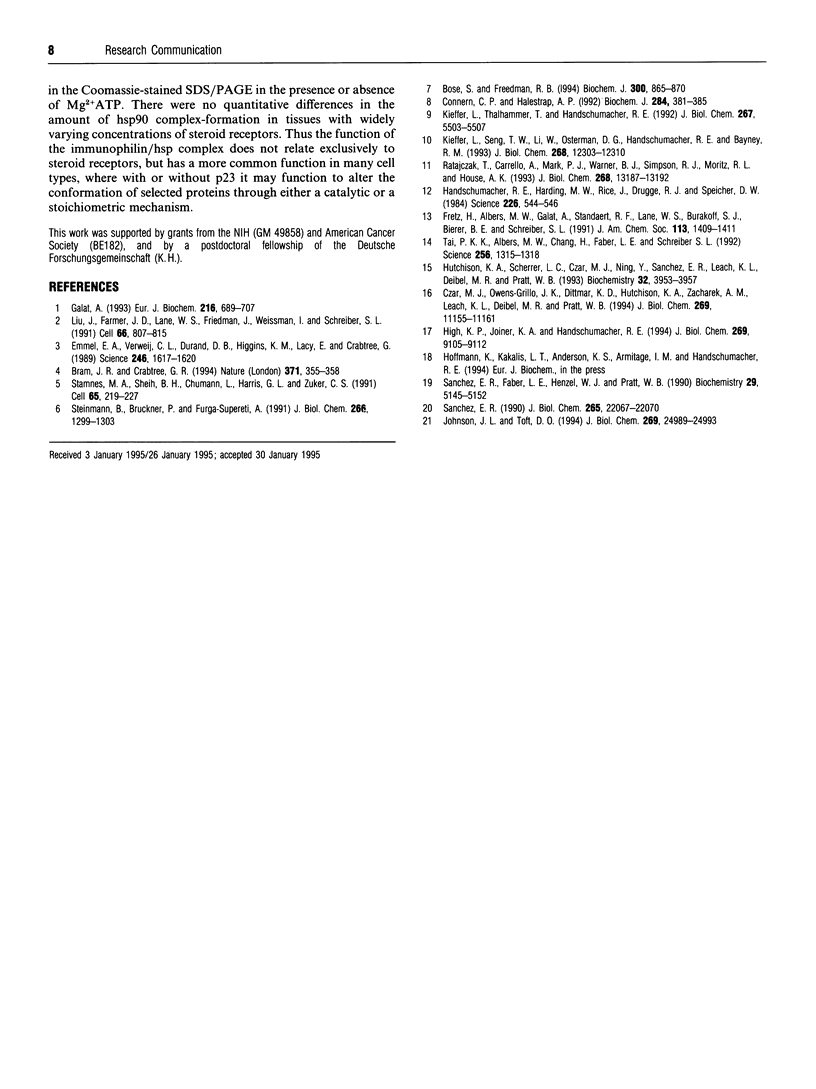
Images in this article
Selected References
These references are in PubMed. This may not be the complete list of references from this article.
- Bose S., Freedman R. B. Peptidyl prolyl cis-trans-isomerase activity associated with the lumen of the endoplasmic reticulum. Biochem J. 1994 Jun 15;300(Pt 3):865–870. doi: 10.1042/bj3000865. [DOI] [PMC free article] [PubMed] [Google Scholar]
- Bram R. J., Crabtree G. R. Calcium signalling in T cells stimulated by a cyclophilin B-binding protein. Nature. 1994 Sep 22;371(6495):355–358. doi: 10.1038/371355a0. [DOI] [PubMed] [Google Scholar]
- Connern C. P., Halestrap A. P. Purification and N-terminal sequencing of peptidyl-prolyl cis-trans-isomerase from rat liver mitochondrial matrix reveals the existence of a distinct mitochondrial cyclophilin. Biochem J. 1992 Jun 1;284(Pt 2):381–385. doi: 10.1042/bj2840381. [DOI] [PMC free article] [PubMed] [Google Scholar]
- Czar M. J., Owens-Grillo J. K., Dittmar K. D., Hutchison K. A., Zacharek A. M., Leach K. L., Deibel M. R., Jr, Pratt W. B. Characterization of the protein-protein interactions determining the heat shock protein (hsp90.hsp70.hsp56) heterocomplex. J Biol Chem. 1994 Apr 15;269(15):11155–11161. [PubMed] [Google Scholar]
- Emmel E. A., Verweij C. L., Durand D. B., Higgins K. M., Lacy E., Crabtree G. R. Cyclosporin A specifically inhibits function of nuclear proteins involved in T cell activation. Science. 1989 Dec 22;246(4937):1617–1620. doi: 10.1126/science.2595372. [DOI] [PubMed] [Google Scholar]
- Galat A. Peptidylproline cis-trans-isomerases: immunophilins. Eur J Biochem. 1993 Sep 15;216(3):689–707. doi: 10.1111/j.1432-1033.1993.tb18189.x. [DOI] [PubMed] [Google Scholar]
- Handschumacher R. E., Harding M. W., Rice J., Drugge R. J., Speicher D. W. Cyclophilin: a specific cytosolic binding protein for cyclosporin A. Science. 1984 Nov 2;226(4674):544–547. doi: 10.1126/science.6238408. [DOI] [PubMed] [Google Scholar]
- High K. P., Joiner K. A., Handschumacher R. E. Isolation, cDNA sequences, and biochemical characterization of the major cyclosporin-binding proteins of Toxoplasma gondii. J Biol Chem. 1994 Mar 25;269(12):9105–9112. [PubMed] [Google Scholar]
- Hutchison K. A., Scherrer L. C., Czar M. J., Ning Y., Sanchez E. R., Leach K. L., Deibel M. R., Jr, Pratt W. B. FK506 binding to the 56-kilodalton immunophilin (Hsp56) in the glucocorticoid receptor heterocomplex has no effect on receptor folding or function. Biochemistry. 1993 Apr 20;32(15):3953–3957. doi: 10.1021/bi00066a015. [DOI] [PubMed] [Google Scholar]
- Johnson J. L., Toft D. O. A novel chaperone complex for steroid receptors involving heat shock proteins, immunophilins, and p23. J Biol Chem. 1994 Oct 7;269(40):24989–24993. [PubMed] [Google Scholar]
- Kieffer L. J., Seng T. W., Li W., Osterman D. G., Handschumacher R. E., Bayney R. M. Cyclophilin-40, a protein with homology to the P59 component of the steroid receptor complex. Cloning of the cDNA and further characterization. J Biol Chem. 1993 Jun 15;268(17):12303–12310. [PubMed] [Google Scholar]
- Kieffer L. J., Thalhammer T., Handschumacher R. E. Isolation and characterization of a 40-kDa cyclophilin-related protein. J Biol Chem. 1992 Mar 15;267(8):5503–5507. [PubMed] [Google Scholar]
- Liu J., Farmer J. D., Jr, Lane W. S., Friedman J., Weissman I., Schreiber S. L. Calcineurin is a common target of cyclophilin-cyclosporin A and FKBP-FK506 complexes. Cell. 1991 Aug 23;66(4):807–815. doi: 10.1016/0092-8674(91)90124-h. [DOI] [PubMed] [Google Scholar]
- Ratajczak T., Carrello A., Mark P. J., Warner B. J., Simpson R. J., Moritz R. L., House A. K. The cyclophilin component of the unactivated estrogen receptor contains a tetratricopeptide repeat domain and shares identity with p59 (FKBP59). J Biol Chem. 1993 Jun 25;268(18):13187–13192. [PubMed] [Google Scholar]
- Sanchez E. R. Hsp56: a novel heat shock protein associated with untransformed steroid receptor complexes. J Biol Chem. 1990 Dec 25;265(36):22067–22070. [PubMed] [Google Scholar]
- Stamnes M. A., Shieh B. H., Chuman L., Harris G. L., Zuker C. S. The cyclophilin homolog ninaA is a tissue-specific integral membrane protein required for the proper synthesis of a subset of Drosophila rhodopsins. Cell. 1991 Apr 19;65(2):219–227. doi: 10.1016/0092-8674(91)90156-s. [DOI] [PubMed] [Google Scholar]
- Tai P. K., Albers M. W., Chang H., Faber L. E., Schreiber S. L. Association of a 59-kilodalton immunophilin with the glucocorticoid receptor complex. Science. 1992 May 29;256(5061):1315–1318. doi: 10.1126/science.1376003. [DOI] [PubMed] [Google Scholar]



